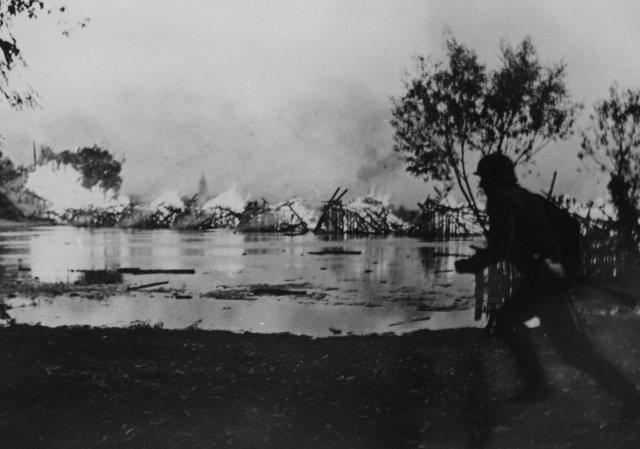Shortly after the Wehrmacht attacked the Soviet Union on June 22, 1941, the first villages were burned down and civilians were murdered.
Photo: picture alliance/photo archive for contemporary history/archive | Photo archive for contemporary history
It cannot be repeated often enough: war is terrible, genocide is inexcusable. Death and destruction, victims and perpetrators must be rescued from oblivion. The memory of the burning of entire villages and the murder and extortion of their residents remains a historical burden for the Germans. But this memory was clouded with regard to the war in the East. The “clean Wehrmacht” did not want to be held liable for such crimes, and in the invaded and occupied areas, the memory was partly obscured by the suppression and concealment of the sad fact that the German aggressors achieved conquests in the “Blitzkrieg,” including in the Soviet Union.
When asked today’s Germans which three European countries they knew were most affected by the Nazis’ war of conquest and annihilation, only one percent of those surveyed named Ukraine. Even fewer, just 0.1 percent, associated the event with Belarus; 36.3 percent said Russia, 8.1 percent said the entire Soviet Union. Only Poland was associated with Nazi crimes by 60 percent of the test subjects.
Apart from the unfortunately not asked question of origin, whether from East or West Germany, this survey points to the growing ignorance of history in West German society. This could worsen further under the influence of the propaganda battle surrounding the current war in Ukraine. It is the task of historians to continually question historical narratives that serve to justify political action. As terrible and condemnable as today’s devastation and crimes are, the rampage of the German fascists in the Second World War must not be trivialized or stripped of its singularity.
nd.DieWoche – our weekly newsletter

With our weekly newsletter nd.DieWoche look at the most important topics of the week and read them Highlights our Saturday edition on Friday. Get your free subscription here.
On the eve of the war in Ukraine, Frank Wieler, Frédéric Bonnesoeur and co-authors went to the locations, battlefields and murder sites of the Nazis in Poland and the former Soviet Union. They spoke to survivors and their descendants, to scientists and memorial staff. They were supported by the Berlin-based association Contacts – Kontakty, of which Bonnesoeur is a board member. Together with historians and activists, they uncovered and documented terrible German atrocities in former Soviet republics.
Compensation for survivors by the Federal Republic – 2,500 euros, according to a Bundestag resolution from 2015, at least to former prisoners of war – may be a satisfaction for those affected, but remains shameful for Germany. It is a purely symbolic “compensation”. Murder and misery cannot be repaired, especially not after three quarters of a century.
In Poland, as in Latvia, Belarus, Ukraine and Russia, the wounds have not yet healed. The authors don’t give anything away to the readers, they go into detail. They deal with the annexation of Ciechanów to Prussia as the Zichenau administrative district after Hitler’s Germany attacked Poland, which violated international law, report on the murderous hunger winter of 1941/42 in the Kharkiv Oblast and recapitulate the extermination of the Latvian village of Audrini. The focus of her research and documentation is the fate of the people on the flat land, which metaphorically appears under the sign of “burnt villages”. “Everything was burning, the sky was no longer visible because of all the smoke,” a contemporary witness is quoted as saying.
The authors do not leave out any group of victims. We remember patients in psychiatric institutions that turned out to be places of murder, the inhumane treatment of prisoners of war, the massacres of Jews and Sinti and Roma, and the summary executions of partisans and their often alleged helpers. On an almost unimaginable scale, citizens of Poland and the occupied territories of the Soviet Union were murdered and left to starve, as “useless eaters,” as an “inferior race.”
The occupied people were faced with occupiers “who had the decisive means of power and who used them without regard for the local civilian population,” it says here. It is estimated that 36.5 million people died as a result of the direct effects of the war. More than half of these people, at least 19 million, were civilians, including 6 million Jews, as the authors note. »The high number of civilian casualties is particularly remarkable. It exceeds the number of military casualties not only in the former Soviet Union, Poland, former Yugoslavia, Hungary and Greece, but also in France, the Netherlands, Belgium and Norway.”
The representations are differentiated and accuse the German fascists as well as collaborators who actively participated in the persecution and murder of Jews, Red Army soldiers and Soviet party and state officials. The complexity of what was happening becomes clear, including the initial hopes of some rural residents for an end to Soviet power and the dissolution of the collective farms by the new rulers. »The high number of victims shows the everyday nature of violence, but should not obscure the fact that the German physical and regulatory presence also meant that locals were often unable to avoid the occupiers and were unable to avoid interactions with them .” Survival strategies included opportunism and collaboration.
Unfortunately, the negation of the actual and not supposed socio-politically and economically progressive and just social system encountered and destroyed in the Soviet territories by the conquerors corresponds to today’s views of the post-socialist-capitalist elites in the regions examined. It would have been exciting to ask about possible differences in occupation policy, persecution and resistance in Poland, which was capitalist until the attack, in the Baltic states annexed to the Soviet Union according to the Secret Additional Protocol of the so-called Hitler-Stalin Pact, and in the Soviet republics.
What was the source of the sacrificial resistance of the partisan units, especially in Ukraine and Belarus, against the invaders, their defense of the fatherland, the Soviet Union, despite all possible conflicts between the population living there and the central power in Moscow? There are still many questions left for research to clarify.
Burnt villages. National Socialist crimes against the rural population in Poland and the Soviet Union during World War II. Ed. Florian Wieler and Frédéric Bonnesoeur with the collaboration of. Sibylle Suchan-Floß. Metropol, 361 pages, hardcover, €29.
#ndstays – Get active and order a promotional package
Regardless of whether it is pubs, cafés, festivals or other meeting places – we want to become more visible and reach everyone who values independent journalism with an attitude. We have put together a campaign package with stickers, flyers, posters and buttons that you can use to get active and support your newspaper.
To the promotional package
